
Ken Shirriff
@righto.com
Computer history. Reverse-engineering old chips. Restored Apollo Guidance Computer, Alto. Ex-Google, Sun, Msft. So-called boffin.
The New York Times recently introduced daily puzzles called Pips. You place the dominoes on the grid so the numbers satisfy the labels.
I solved Pips with cool software called a constraint solver. You give the constraints, e.g. "sum to 8", and it "magically" finds a solution. Let's look closer...
I solved Pips with cool software called a constraint solver. You give the constraints, e.g. "sum to 8", and it "magically" finds a solution. Let's look closer...

October 18, 2025 at 4:20 PM
The New York Times recently introduced daily puzzles called Pips. You place the dominoes on the grid so the numbers satisfy the labels.
I solved Pips with cool software called a constraint solver. You give the constraints, e.g. "sum to 8", and it "magically" finds a solution. Let's look closer...
I solved Pips with cool software called a constraint solver. You give the constraints, e.g. "sum to 8", and it "magically" finds a solution. Let's look closer...
We fixed the vintage IBM printer at the Computer History Museum yesterday. Introduced in 1959, the IBM 1403 line printer provided fast, high-quality output, printing 132 character lines. Unfortunately, one column stopped printing, so we disassembled the printer to fix a bad hammer. Keep reading...

October 2, 2025 at 9:54 PM
We fixed the vintage IBM printer at the Computer History Museum yesterday. Introduced in 1959, the IBM 1403 line printer provided fast, high-quality output, printing 132 character lines. Unfortunately, one column stopped printing, so we disassembled the printer to fix a bad hammer. Keep reading...
The iPhone 17 is powered by Apple's A19 SoC (System on a Chip). Chipwise took a die photo of the chip, but it's a bit drab. I spiced it up by applying the over-saturated color gradient that Apple used for die photos of the M1 chip :-)
Link to the original die photo: chipwise.tech/our-portfoli...
Link to the original die photo: chipwise.tech/our-portfoli...

September 23, 2025 at 11:39 PM
The iPhone 17 is powered by Apple's A19 SoC (System on a Chip). Chipwise took a die photo of the chip, but it's a bit drab. I spiced it up by applying the over-saturated color gradient that Apple used for die photos of the M1 chip :-)
Link to the original die photo: chipwise.tech/our-portfoli...
Link to the original die photo: chipwise.tech/our-portfoli...
Celebrated Navajo (Diné) artist Marilou Schultz recently completed a striking weaving. Although this rug may appear abstract, it is a representation of the wiring inside an integrated circuit. It shows the 555 timer, said at one point to be the world's most popular IC. Let's take a closer look...

September 6, 2025 at 3:25 PM
Celebrated Navajo (Diné) artist Marilou Schultz recently completed a striking weaving. Although this rug may appear abstract, it is a representation of the wiring inside an integrated circuit. It shows the 555 timer, said at one point to be the world's most popular IC. Let's take a closer look...
The latest issue of @science.org mentions a magnetic compound Cr2Gr2Te6. The element Gr confused me, but it turned out to be a typo for Ge, germanium. Strangely, I found multiple papers with the same typo in the same context, so I wrote a short blog post about it.
www.righto.com/2025/08/Cr2G...
www.righto.com/2025/08/Cr2G...

August 18, 2025 at 6:47 PM
The latest issue of @science.org mentions a magnetic compound Cr2Gr2Te6. The element Gr confused me, but it turned out to be a typo for Ge, germanium. Strangely, I found multiple papers with the same typo in the same context, so I wrote a short blog post about it.
www.righto.com/2025/08/Cr2G...
www.righto.com/2025/08/Cr2G...
How did Intel's 386 processor connect to the outside world? Tiny wires connect to the bond pads around the edges. Special input/output circuits—visible in zoomed-in blocks—send and receive signals while protecting the chip from dangers that could destroy it. Let's take a look... 1/N

August 17, 2025 at 2:45 PM
How did Intel's 386 processor connect to the outside world? Tiny wires connect to the bond pads around the edges. Special input/output circuits—visible in zoomed-in blocks—send and receive signals while protecting the chip from dangers that could destroy it. Let's take a look... 1/N
Intel's 386 processor was popular in late 1980s microcomputers. From the outside, the 386 chip is a boring ceramic square. But I obtained a 3-dimensional CT X-ray scan from Lumafield, revealing six layers of complex wiring hidden inside the ceramic package. Let's take a closer look... 1/N
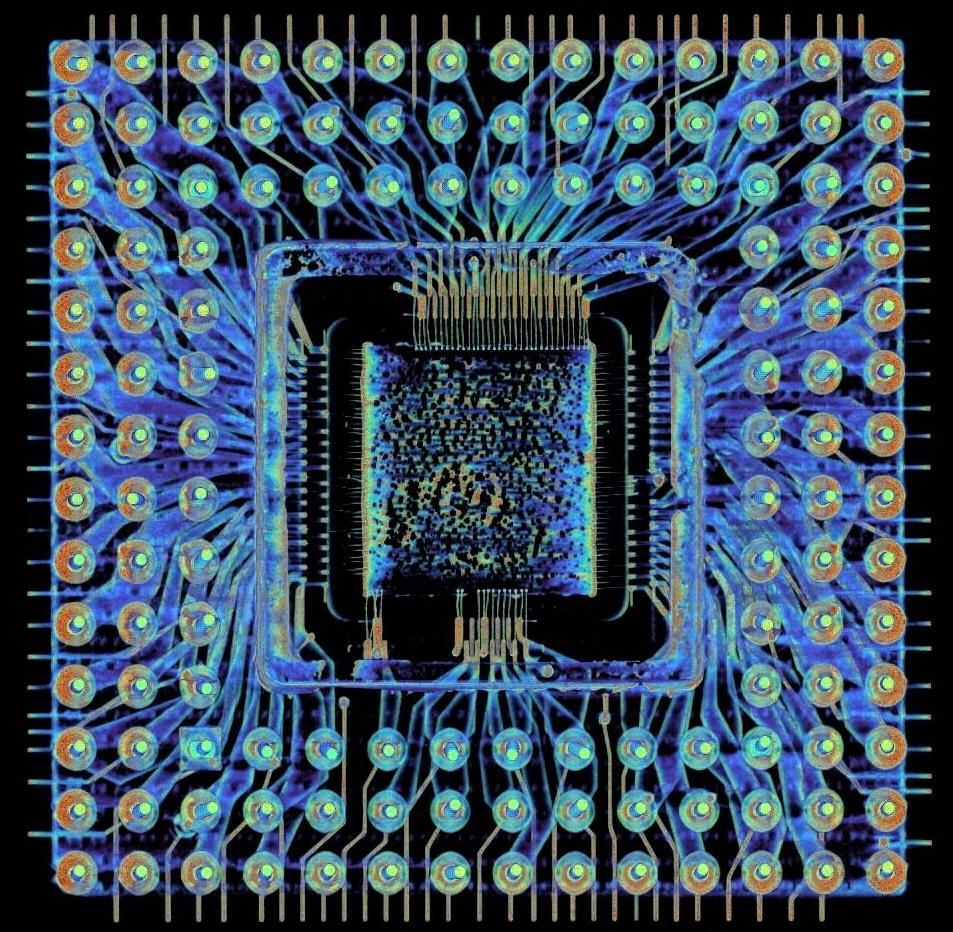
August 9, 2025 at 4:40 PM
Intel's 386 processor was popular in late 1980s microcomputers. From the outside, the 386 chip is a boring ceramic square. But I obtained a 3-dimensional CT X-ray scan from Lumafield, revealing six layers of complex wiring hidden inside the ceramic package. Let's take a closer look... 1/N
In 1983, Philips produced the first FM radio receiver on a chip, leading to products such as the FM radio wristwatch. Let's look at the tiny silicon die inside this chip and see how it works. 1/N
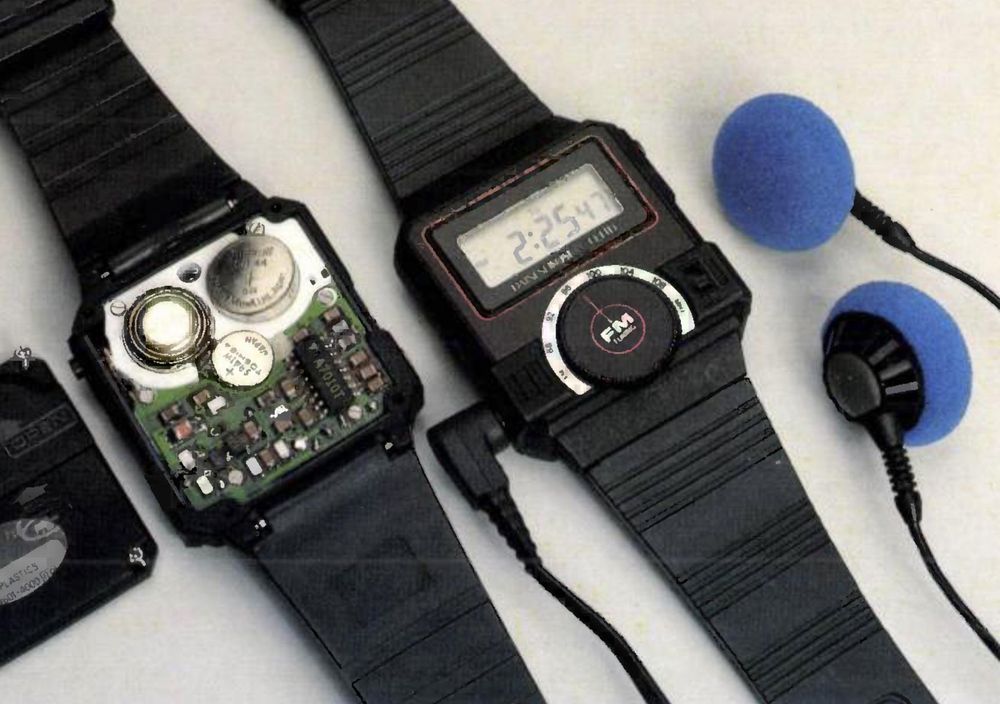
August 2, 2025 at 3:49 PM
In 1983, Philips produced the first FM radio receiver on a chip, leading to products such as the FM radio wristwatch. Let's look at the tiny silicon die inside this chip and see how it works. 1/N
We obtained a mysterious box of 1960s electronics. I reverse-engineered it, and with much effort, we got it running. It turns out to be a test unit for testing NASA's Up-Data Link, a system from the Apollo moon landing to control the spacecraft from the ground. Let's take a look inside... 1/n
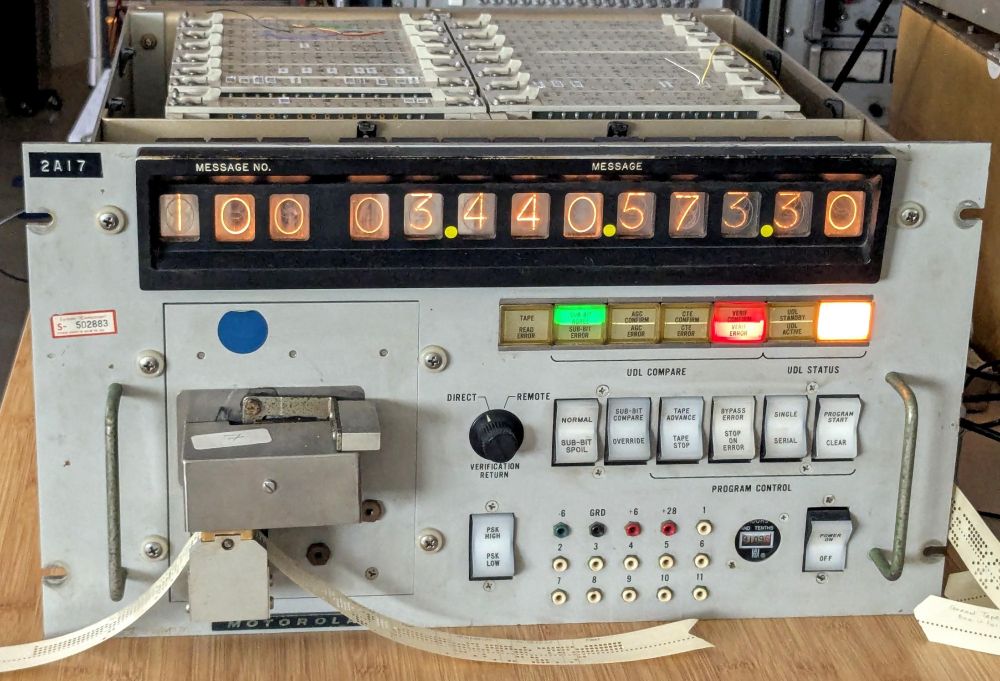
July 21, 2025 at 4:58 PM
We obtained a mysterious box of 1960s electronics. I reverse-engineered it, and with much effort, we got it running. It turns out to be a test unit for testing NASA's Up-Data Link, a system from the Apollo moon landing to control the spacecraft from the ground. Let's take a look inside... 1/n
We're at OpenSauce 2025, showing off Apollo hardware, electromechanical computers, the MOnSter 6502, and other treats. Join me, @tubetime.bsky.social, and Mike at the CuriousMarc booth!
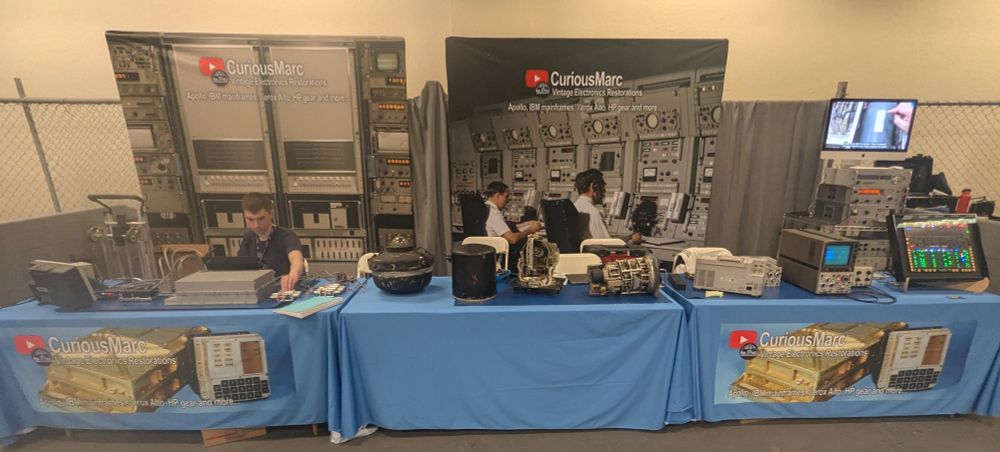
July 19, 2025 at 4:01 PM
We're at OpenSauce 2025, showing off Apollo hardware, electromechanical computers, the MOnSter 6502, and other treats. Join me, @tubetime.bsky.social, and Mike at the CuriousMarc booth!
I'll be at OpenSauce 2025 along with @curiousmarc.bsky.social, @tubetime.bsky.social, and Mike. We plan to show some Apollo hardware, atomic clocks, vintage avionics, and who knows what else, so stop by if you're attending.
opensauce.com
opensauce.com

Open Sauce 2025 - Open Sauce
A Celebration Of Makers And Creators. A three-day event in San Francisco Bay Area at San Mateo County Event Center. Attendees will explore...
opensauce.com
July 14, 2025 at 6:50 PM
I'll be at OpenSauce 2025 along with @curiousmarc.bsky.social, @tubetime.bsky.social, and Mike. We plan to show some Apollo hardware, atomic clocks, vintage avionics, and who knows what else, so stop by if you're attending.
opensauce.com
opensauce.com
The Globus is a navigational instrument that uses a rotating globe to show the position of the Soyuz spacecraft above the Earth. Inside the Globus, a complicated system of gears and motors positions the globe. @jonbruner.bsky.social at Lumafield created a three-dimensional X-ray scan for us. 1/4
July 11, 2025 at 12:52 AM
The Globus is a navigational instrument that uses a rotating globe to show the position of the Soyuz spacecraft above the Earth. Inside the Globus, a complicated system of gears and motors positions the globe. @jonbruner.bsky.social at Lumafield created a three-dimensional X-ray scan for us. 1/4
In the 1960s, this absurdly large camera was used to make masks for integrated circuits. The layers of the integrated circuit were drawn at large scale and then optically shrunk to make the glass masks that were used in manufacturing.

June 25, 2025 at 5:33 PM
In the 1960s, this absurdly large camera was used to make masks for integrated circuits. The layers of the integrated circuit were drawn at large scale and then optically shrunk to make the glass masks that were used in manufacturing.
Last week, the vintage IBM 1401 computer at the Computer History Museum started behaving strangely: it wouldn't halt. More specifically, if you had two HALT instructions in a row, it would halt for the first, but when you continued, it crashed mysteriously. Here's how we fixed it.... 1/N
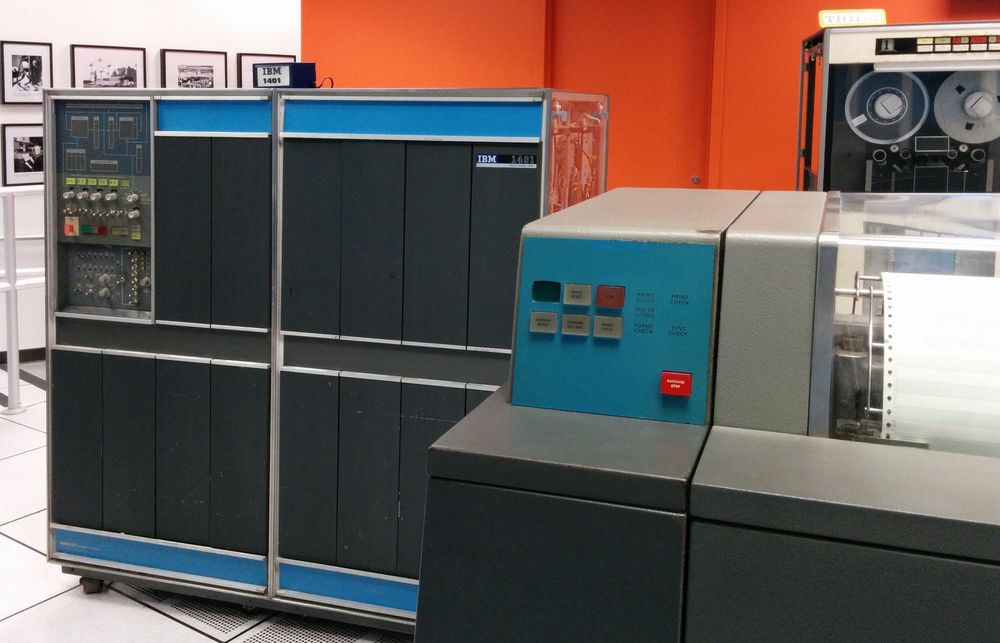
June 20, 2025 at 2:57 AM
Last week, the vintage IBM 1401 computer at the Computer History Museum started behaving strangely: it wouldn't halt. More specifically, if you had two HALT instructions in a row, it would halt for the first, but when you continued, it crashed mysteriously. Here's how we fixed it.... 1/N
When landing on the Moon, the astronauts watched an instrument called the FDAI that showed the spacecraft's orientation. The ball inside the Flight Director/Attitude Indicator rotated in three axes as the Lunar Module rotated. Let's look inside and see how it works. 1/N
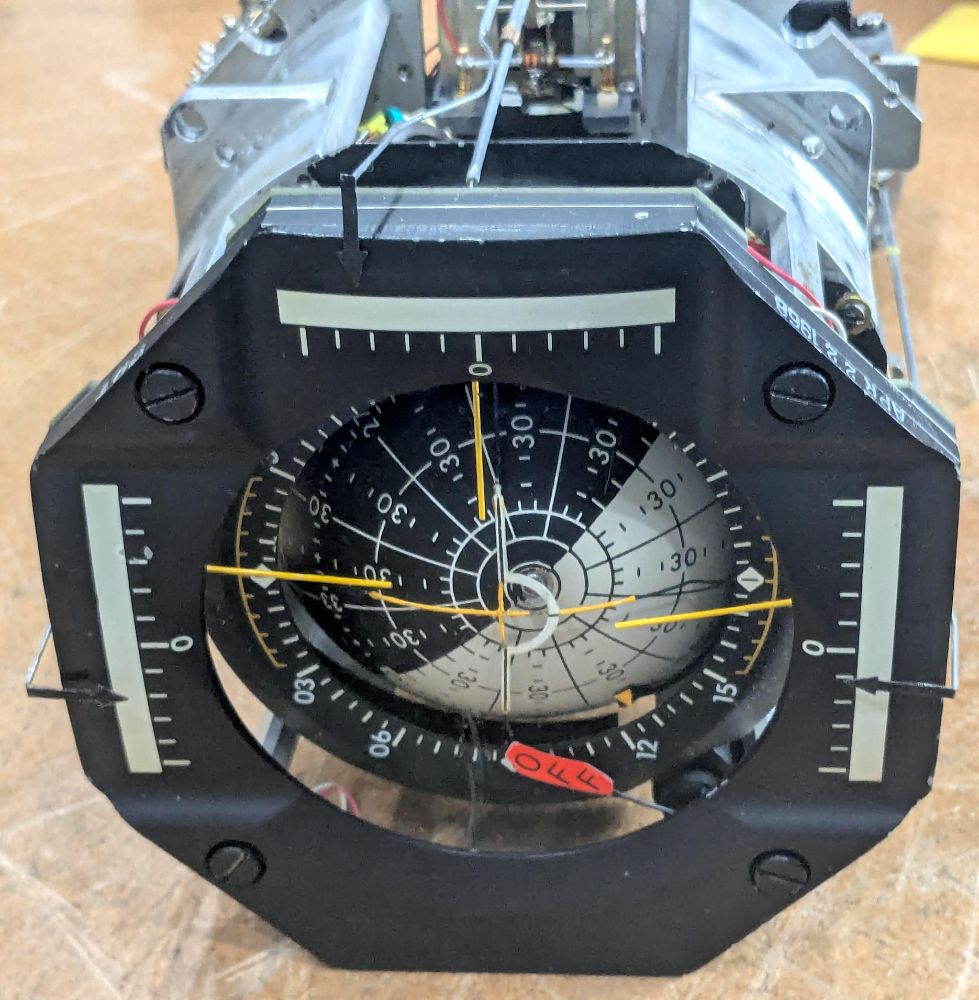
June 14, 2025 at 3:37 PM
When landing on the Moon, the astronauts watched an instrument called the FDAI that showed the spacecraft's orientation. The ball inside the Flight Director/Attitude Indicator rotated in three axes as the Lunar Module rotated. Let's look inside and see how it works. 1/N
This photo of magnetic core memory popped up, taken by Ansel Adams. I investigated a bit: this memory holds 4000 bits, each stored in a tiny magnetized ferrite ring. It may be from an IBM 705 vacuum-tube business computer. 1/N
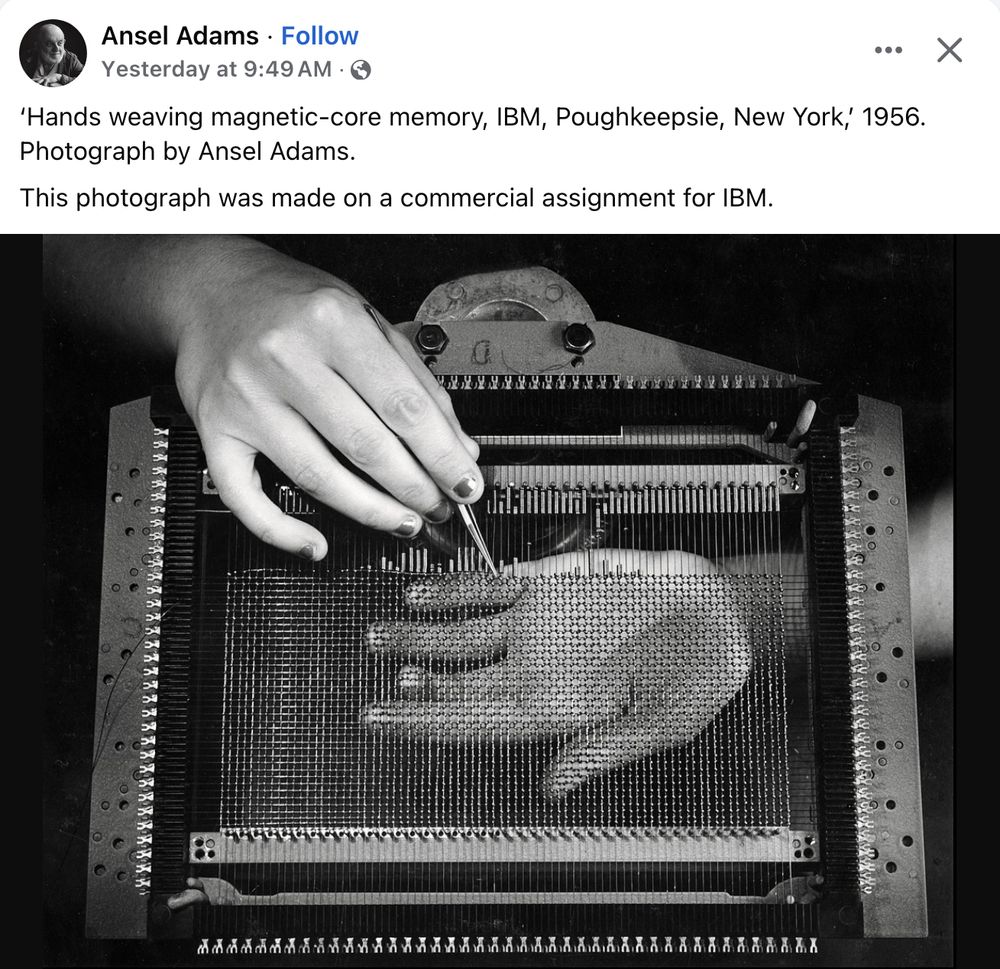
May 30, 2025 at 5:38 PM
This photo of magnetic core memory popped up, taken by Ansel Adams. I investigated a bit: this memory holds 4000 bits, each stored in a tiny magnetized ferrite ring. It may be from an IBM 705 vacuum-tube business computer. 1/N
In the Apollo space program, the FDAI (Flight Director Attitude Indicator) showed the orientation of the spacecraft through a ball that rotates on three axes. The yellow needles and black pointers show error and movement rate. This FDAI was later modified for use in a Space Shuttle simulator.

May 21, 2025 at 4:21 PM
In the Apollo space program, the FDAI (Flight Director Attitude Indicator) showed the orientation of the spacecraft through a ball that rotates on three axes. The yellow needles and black pointers show error and movement rate. This FDAI was later modified for use in a Space Shuttle simulator.
How thin is spider silk compared to the wiring on a chip? Here's a close-up of a spiderweb strand diagonally across an Intel 386 processor. The spiderweb is 4 µm thick, just a bit thinner than this 1985 chip's 5 µm metal wiring. Wiring in modern chips is 100 times thinner.

May 17, 2025 at 7:01 PM
How thin is spider silk compared to the wiring on a chip? Here's a close-up of a spiderweb strand diagonally across an Intel 386 processor. The spiderweb is 4 µm thick, just a bit thinner than this 1985 chip's 5 µm metal wiring. Wiring in modern chips is 100 times thinner.
Tape drive repair at @computerhistory.bsky.social. I helped @tubetime.bsky.social figure out why the tape drives wouldn't backspace. The problem turned out to be a bad germanium transistor on an inverter card. 1/5
May 16, 2025 at 9:39 PM
Tape drive repair at @computerhistory.bsky.social. I helped @tubetime.bsky.social figure out why the tape drives wouldn't backspace. The problem turned out to be a bad germanium transistor on an inverter card. 1/5
Anyone use Intel's 386 processor from 1985, the first 32-bit x86? To improve performance, it preloaded instructions into a 16-byte prefetch queue (highlighted in red). Why does such a small queue take up so much of the chip? Let's look under the microscope at its complicated circuitry... 1/N
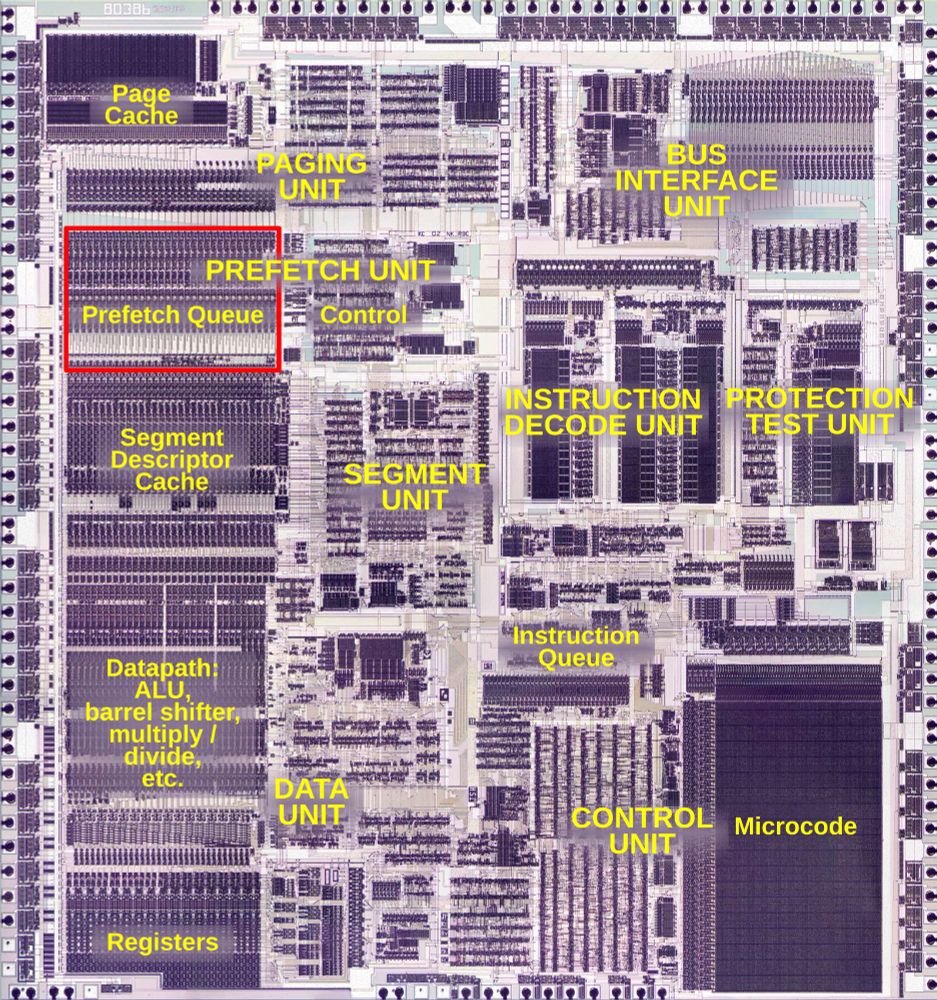
May 10, 2025 at 4:23 PM
Anyone use Intel's 386 processor from 1985, the first 32-bit x86? To improve performance, it preloaded instructions into a 16-byte prefetch queue (highlighted in red). Why does such a small queue take up so much of the chip? Let's look under the microscope at its complicated circuitry... 1/N
Intel's 386 processor (1985) moved the x86 architecture to 32 bits, but it needed to be backward compatible with earlier 16 and 8-bit processors. As a result, it needed complicated circuitry for its internal registers: six different circuits for 30 registers. Let's look at the silicon circuits. 1/N
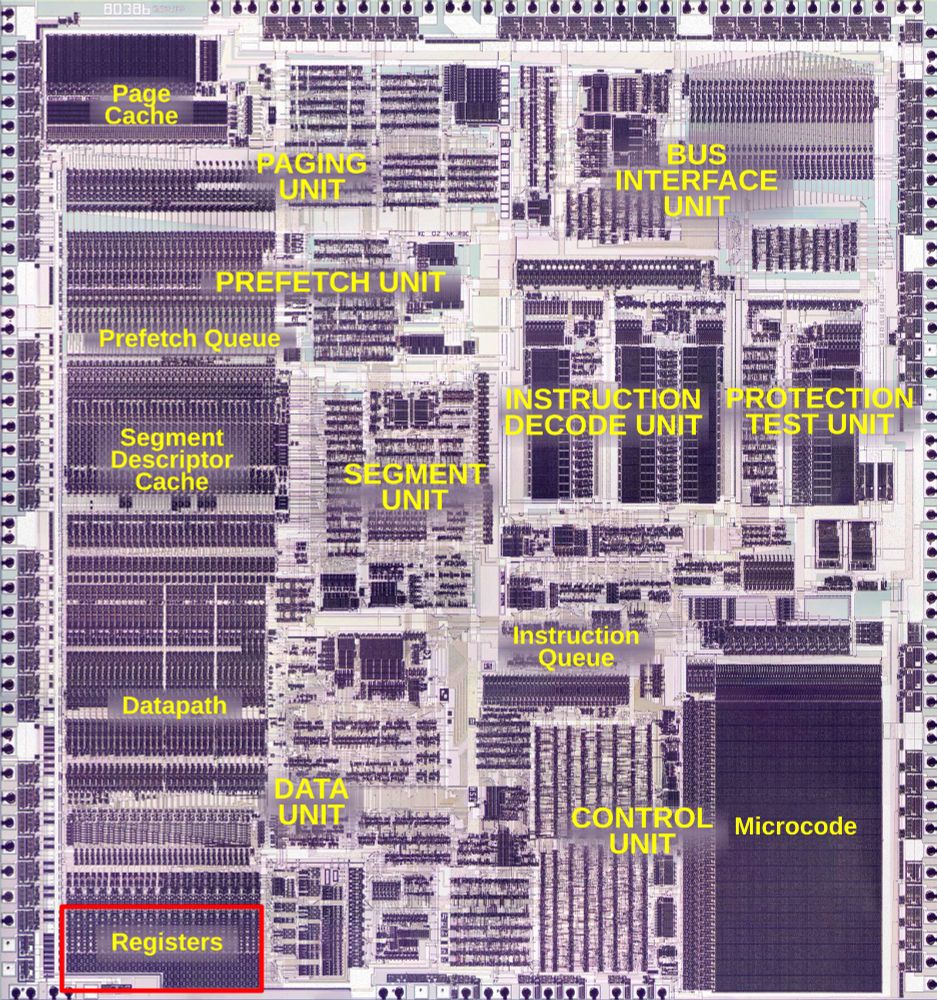
May 1, 2025 at 5:40 PM
Intel's 386 processor (1985) moved the x86 architecture to 32 bits, but it needed to be backward compatible with earlier 16 and 8-bit processors. As a result, it needed complicated circuitry for its internal registers: six different circuits for 30 registers. Let's look at the silicon circuits. 1/N
If you were following my recent repair of a vintage Commodore PET home computer, you may enjoy this video from @curiousmarc.bsky.social:

Hard to repair Commodore PET
YouTube video by CuriousMarc
youtu.be
April 24, 2025 at 3:35 PM
If you were following my recent repair of a vintage Commodore PET home computer, you may enjoy this video from @curiousmarc.bsky.social:
The Commodore PET, along with the Apple II and the Radio Shack TRS-80, formed the "1977 Trinity" that made home computers popular. The PET was very quirky, combining a tiny keyboard, a cassette drive for storage, and a monitor in a trapezoidal case. I got one, but it didn't work. Let's fix it... 1/N
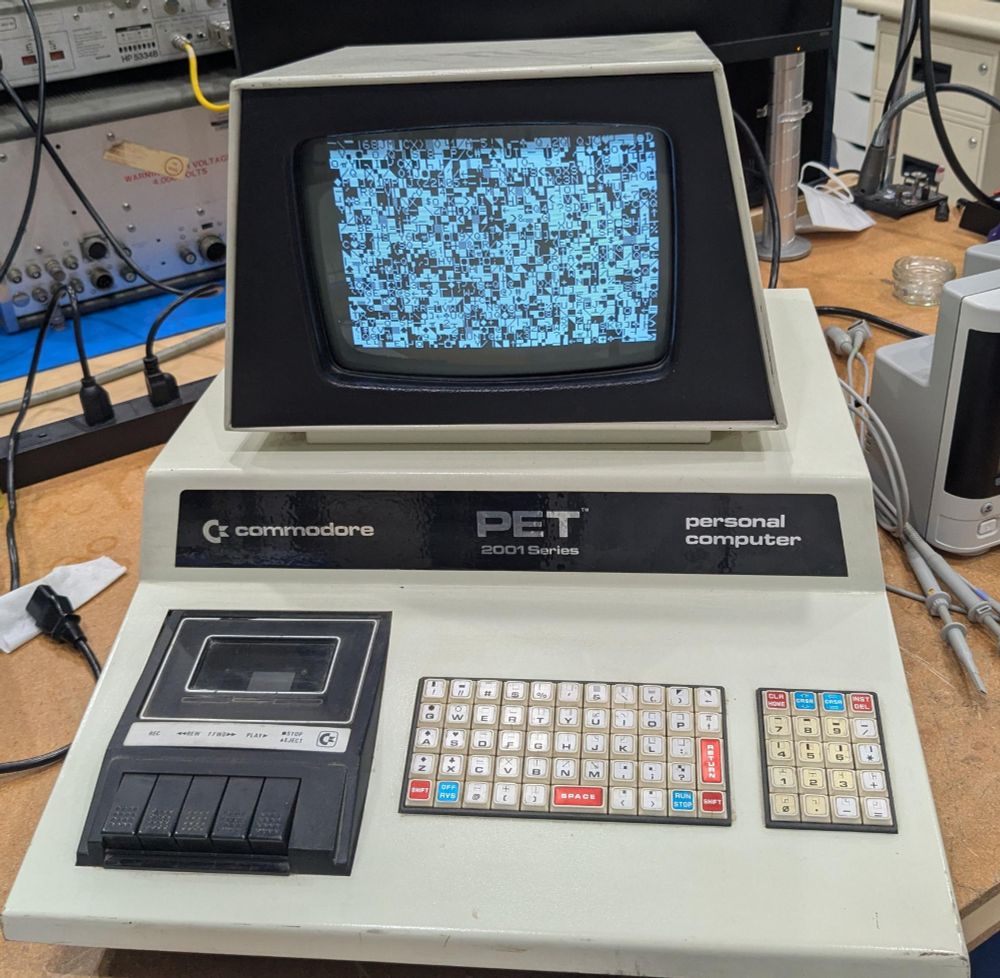
April 13, 2025 at 4:15 PM
The Commodore PET, along with the Apple II and the Radio Shack TRS-80, formed the "1977 Trinity" that made home computers popular. The PET was very quirky, combining a tiny keyboard, a cassette drive for storage, and a monitor in a trapezoidal case. I got one, but it didn't work. Let's fix it... 1/N
If any of my followers want to read about the Pentium in German, one of my articles has been translated:
www.heise.de/hintergrund/...
www.heise.de/hintergrund/...

Zahlen, bitte! Verrückt: Für ×3 brauchte der Pentium einen eigenen Schaltkreis
Der Intel Pentium hat einen separaten Abschnitt nur für die Multiplikation mit 3. Dieser verfügt über mehr Transistoren, als ein Z80 insgesamt hatte. (Teil 1)
www.heise.de
April 2, 2025 at 3:44 AM
If any of my followers want to read about the Pentium in German, one of my articles has been translated:
www.heise.de/hintergrund/...
www.heise.de/hintergrund/...
The Pentium processor, like many others, implements its instructions in microcode. Each step of an instruction is described by a micro-instruction, stored in the chip in the microcode ROM.
This die photo shows the parts of the Pentium. Let's take a quick look at the microcode ROM...1/N
This die photo shows the parts of the Pentium. Let's take a quick look at the microcode ROM...1/N

March 31, 2025 at 5:40 PM
The Pentium processor, like many others, implements its instructions in microcode. Each step of an instruction is described by a micro-instruction, stored in the chip in the microcode ROM.
This die photo shows the parts of the Pentium. Let's take a quick look at the microcode ROM...1/N
This die photo shows the parts of the Pentium. Let's take a quick look at the microcode ROM...1/N

